Current and Emerging Laser Sensors for Greenhouse Gas Detection and Monitoring
In the study of global warming, obtaining good data demands widely deployed, accurate, and reliable sensors for identifying and understanding the origins, sources, and fates of greenhouse gases. Sensing technologies based on tunable diode laser absorption spectroscopy are starting to provide some of this critical data.

This article discusses current and emerging tools based on tunable diode laser absorption spectroscopy (TDLAS) for greenhouse gas detection and monitoring, and concludes with some of the technical challenges to overcome in the quest to realize "ubiquitous monitoring."
As scientists, we all know that good science demands good data. In the study of global warming, obtaining good data demands widely deployed, accurate, and reliable sensors for identifying, understanding, and controlling the origins, sources, sinks, and fates of greenhouse gases, especially carbon dioxide (CO2) and methane (CH4). Sensor networks will ideally monitor and map, spatially and temporally, greenhouse gas concentrations with sufficient sensitivity and resolution to distinguish local sources from ambient background and provide fast health and safety danger alerts. These networks will be supplemented by methods for synthesizing, distributing, and using the data provided by the sensors.
This article discusses current and emerging tools based on tunable diode laser absorption spectroscopy (TDLAS) that address these needs, and concludes with some of the technical challenges to overcome in the quest to realize "ubiquitous monitoring."
Sensor Purposes
Methane
Biogenic and anthropogenic methane sources both contribute to greenhouse gas loading. Anthropogenic sources can be controlled and limited if their origins are located. Significant sources are landfills, bovine farms, and the natural gas system, which in the United States includes nearly 500,000 active wells, 300,000 miles of transmission pipelines, and over 1,200,000 miles of distribution pipelines. Natural gas leaks are potential safety risks as well as greenhouse gas sources. Thus, maintaining the system's security and integrity is a legally regulated process of monitoring pipeline flow conditions to recognize abnormal events that may indicate leaks and ruptures, supplemented by scheduled periodic walking, driving, or aerial surveys for locating and repairing leaks.
With increasing national emphasis on natural gas as an abundant energy resource, there is increased emphasis on improving leak detection and mitigation. Recent studies show considerable uncertainty in the leakage rate from gas production sites — it ranges from 0.42% (1) to 11% (2). Table I, extracted from a recent study prepared by the office of U.S. Senator Edward Markey, summarizes the national impact of this leakage (3).

Table I: US unaccounted for gas, emissions, and significant incidents on natural gas systems (3)
High leakage rates have the potential to offset the climate benefits of natural gas over other fossil fuels. Some leakage is believed to be intermittent — but significant — and thus is not detected with routine infrequent leak surveying (4). Continually operating cost-effective leak detector networks, when located judiciously, can help identify these intermittent sources. Continuous monitoring can also provide early warning of abnormal gas concentrations that may indicate a potential safety hazard.
Carbon Dioxide
CO2 is created by combusting fossil fuels, including natural gas, and is participating in climate change (5). To slow or reverse the trend of increasing atmospheric concentration of CO2, geologic carbon sequestration (GCS) is emerging as a strategy for restraining the anthropogenic CO2 flux. GCS involves separating CO2 from combustion effluent, transporting it via pipeline to storage sites, and injecting it at high pressure into storage reservoirs several thousand feet deep. In essence, the process is the opposite of natural gas extraction, but uses very similar pipeline infrastructure. The current 3900 miles of CO2 pipeline in the US is projected to grow to 120,000 miles to support GCS deployment (6), and these pipelines will be subjected to leak detection and repair much like the natural gas pipeline infrastructure. Furthermore, monitoring CO2 at sequestration sites is critical for assuring that the sequestration process is safe and performing its intended purpose — that is, storing CO2 without leakage. Much like natural gas leaks, any leaks from underground sequestration infrastructure, including reservoirs, are likely to be diffusely spread through the ground to emerge from a relatively broad area and be transported by the wind. Thus, economical distributed surface sensor networks with high sensitivity and precision are needed to distinguish leaking CO2 from ambient CO2. The measurement technologies must be sensitive enough to discern CO2 leakage signals that may barely rise above the variations in natural background CO2 concentrations occurring on diurnal to interannual time scales and provide spatial resolution sufficient to localize leak origins.
TDLAS Sensors
Sensors based on near-infrared wavelengths (NIR, 1.0–2.5 μm) midwave-IR (MWIR, 3–12 μm) TDLAS are emerging to fulfill these greenhouse gas sensing needs. TDLAS sensors provide fast, highly sensitive measurement of a selected gas or set of gases in complex mixtures. They couple telecommunications-style diode lasers with straightforward spectroscopic principles and detection techniques (7).
Near-IR TDLAS emerged from the laboratory as a practical analytical tool about 20 years ago (8) and is now a proven mature technology (9,10) commercially successful in industrial markets such as process monitoring and control, quality assurance, environmental sensing, plant safety, and infrastructure security that demand sensitive and gas-specific detection of abnormal conditions with minimal false positive occurrences and down time. Indeed, some of the largest present applications of TDLAS are in the natural gas industry for pipeline leak surveying as well as monitoring pipeline gas quality. The remote methane leak detector (RMLD, Heath Consultants Inc.) is an example (11). Enabled by a state-of-the-art low-cost, low-power TDLAS platform, the detector was introduced commercially in 2005. Nearly 2500 of these handheld units are now in use worldwide for walking surveys of natural gas transmission and distribution pipeline networks. Surveying with the detector from vehicles and aircraft has been demonstrated, as has its ability to sense methane emissions from landfills. Units reconfigured as a standoff CO2 sensors have detected CO2 pipeline leakage and human breath (12).
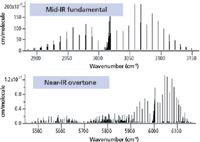
Figure 1: CH4 absorption spectra in the MWIR fingerprint region and NIR overtone, illustrating the 200Ã linestrength advantage of the fundamental.
Attractive features of commercial NIR TDLAS sensors include reliable laser sources, high precision, very low power consumption (<1 W), compact design, minimal maintenance requirements, and an acceptable cost of ~$10,000 per sensor unit. Using sensitive detection techniques such as wavelength modulation spectroscopy (WMS), NIR TDLAS sensors probe overtones of fundamental molecular rotational-vibration energy-state transitions (Figure 1) and can sense over a dozen simple molecules at parts-per-million concentrations (Table II). The noise equivalent absorption (NEA) for NIR TDLAS sensors is typically on the order of 0.00001 at 0.1 Hz.
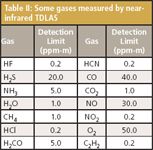
Table II: Some gases measured by near-infrared TDLAS
During the past decade, semiconductor quantum cascade lasers (QCLs) and interband cascade lasers (ICLs) have emerged as miniature industrial quality MWIR laser sources suitable for sensing in the molecular fingerprint spectral region (13,14), where absorption linestrengths are orders-of-magnitude stronger than the NIR. The MWIR region offers opportunities for sensing complex molecules that are difficult to detect with NIR TDLAS, as well as sensor miniaturization by enhancing sensitivity to simple molecules over shorter optical pathlengths. Ongoing research efforts to reduce MWIR sensor noise and power requirements by use of uncooled pulsed or low-power laser sources and small area uncooled detectors, and to reduce MWIR laser cost by high-volume production, is starting to make MWIR TDLAS sensors commercially attractive in niche markets that cannot be addressed by NIR.
TDLAS Configurations
The TDLAS platform provides a technical foundation for a suite of sensors configured specifically for greenhouse gas sensing. Figure 2 illustrates the fundamental components of a TDLAS sensor: the laser transmitter, measurement path, and signal processor. Usually the laser transmitter and signal processor functions are combined in a "control unit." The laser transmitter unit generates a wavelength-agile (that is, tunable) laser beam. An optical fiber may conduct the laser beam from its origin at the laser transmitter to the measurement path. At the beginning of the measurement path, the laser beam enters a gas mixture sample. At the opposite end of the measurement path, the laser beam impinges upon a photodetector that converts the laser beam's power, attenuated by target gas absorption, into an electrical signal. The signal processor unit interprets the electrical signal and outputs information via a local display and a remote communications signal.

Figure 2: Fundamental components of a laser-based gas analyzer.
Some common measurement path configuration examples include extractive, point, long-path, in situ, and standoff. Each of these is relevant to greenhouse sensing. They are described and illustrated briefly here.
Point and Extractive
Point and extractive sensors comprise an optical cell installed in a measurement chamber through which gas flows either passively or by active pumping (Figure 3). The optical pathlength is designed to provide the required sensitivity. Multipass optics, which reflect the laser beam many times between a pair of mirrors, can provide an extended optical pathlength within a small volume. Uses: Permanent or portable sampling to measure local target gas concentrations or locate leaks.
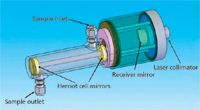
Figure 3: Example of a point sensor.
Long Path
In a long-path sensor, a transceiver projects the laser beam onto a remote surface, and receives laser light returned from the surface (Figure 4). A simple reflective highway sign is a suitable target for pathlengths of ~1000 ft. Uses: Continuous and permanent pipeline health and safety monitoring; fugitive emission localization via multisensor networks.

Figure 4: Long-path sensor configuration.
In Situ
In situ sensors (Figure 5) have optical configurations like long-path sensors, but the laser beam transits a process gas stream (for example, a combustion effluent). Use: Monitoring and controlling CO2 separation processes.
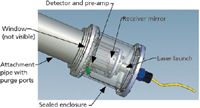
Figure 5: Example of an in situ sensor transceiver.
Standoff
Standoff sensors (Figure 6) are like long-path sensors but project the laser beam onto a noncooperative surface and collect a fraction of the passively scattered laser light. They deduce the amount of target gas in the laser path between the transceiver and the illuminated surface. Use: Surveying pipelines.
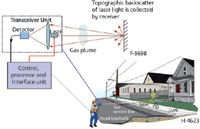
Figure 6: Standoff TDLAS, exemplified by the remote methane leak detector (RMLD, Physical Sciences Inc.).
Mobile
Mobile sensors (Figure 7) are standoff sensors installed on a vehicle or aircraft (15). Uses: Mapping gathering fields, sequestration sites, and landfills; surveying pipelines.
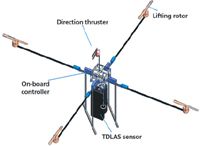
Figure 7: Experimental aerial standoff TDLAS on a small unmanned quadrotor. Adapted from reference 15.
The TDLAS sensor configurations described above can be included in a spatially distributed network of sensors that communicate among each other or with a centralized network interface to enable spatial and temporal mapping of gas concentrations. The use of fiber optics enables multiplexing TDLAS sensors to monitor multiple target gases in each measurement path (16).
Continuous Monitor Demonstrations
Figure 8 illustrates an example of a long-path sensor network under consideration for continuous monitoring of natural gas and carbon dioxide pipelines. The eye-safe laser beams traverse across and above a pipeline to detect leaks and, upon detection, the sensor transmits alerts to the pipeline operator. The sensors ignore temporary disruptions because of passing vehicles and are insensitive to vehicle emissions.
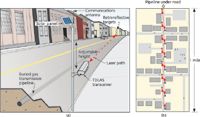
Figure 8: Pipeline monitor concept: (a) Example installation of open-path pipeline leak monitor. (b) Bird’s eye view of network protecting extended length of pipeline. Red arrows illustrate laser beam paths.
In recent early testing of this configuration, remote sensor technology was adapted into permanently installed continuous and autonomous long-path sensors for CO2 and CH4 pipeline leak detection and alarm reporting (17–20). Pictured in Figure 9, the transceiver, installed in a weatherproof NEMA 4 enclosure, mounted to a post with a colocated solar panel and a local RF link to a remote computer that stored data, processed the data to recognize leak signatures, and transmitted alarms via a cellular internet connection.

Figure 9: Long-path CH4 sensor at test site.
These sensors operated continuously for months at three field test locations: the PSI facility in Andover, Massachusetts, the Illinois Basin — Decatur Project (IBDP) GCS validation site, and the Pacific Gas and Electric training facility in Livermore, California. At each site, target gas leaks were manufactured artificially or resulted from maintenance of pipeline infrastructure. Data were acquired to demonstrate sensor efficacy, evaluate sensor response to leaks in typical operating scenarios and weather conditions, and verify sensor freedom from false alarms including any resulting from sensitivity to other ambient gases. The data reveal that CO2 and CH4 leaks create distinct statistical signatures: Turbulent leak plumes cause rapid fluctuations that are readily distinguished from relatively slow natural background variations (for example, diurnal fluctuations). Figure 10 shows example data from the CH4 sensor. The CO2 sensor data are similar. These wireless, solar-powered sensors, combined with proprietary statistical processing algorithms, have demonstrated the capability to discern the signatures of small leaks; detected CH4 leaks as small as 0.5 scfh, comparable to the gas flow rate of a pilot light; and activated real-time notification of leakage. When fully deployed, the envisioned pipeline protection network will facilitate identifying fugitive leaks that contribute to greenhouse gas loads and pose potential personnel safety hazards.
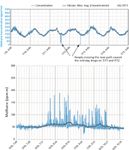
Figure 10: Example long-path CH4 sensor data illustrating diurnal variation of ambient CH4 (upper plot); period of leakage from a source upwind of the laser path (lower plot).
Sensor-on-a-Chip Platform Concept
For widespread deployment of low-cost point sensor networks, prototype chip-scale low-power integrated-optic gas-phase sensors based on MWIR TDLAS are in early development. Figure 11 illustrates a sensor element and TDLAS package concept intended for low-cost mass production and low power consumption (21). Practical challenges to fabricating these sensors include selecting and designing the high-Q micro-resonator sensing element appropriate for the selected analyte; coupling laser light into and out of the sensing element; and device thermal management, especially stabilizing laser temperature with the precision needed for sensitive spectroscopic detection. Novel gas sensing elements using low-loss silicon resonant waveguides, providing effective optical pathlengths that are orders of magnitude greater than their physical dimensions, will permit compact integration of a laser source, sampling elements, and detector in configurations suitable for inexpensive mass production. Recently developed interband cascade lasers that operate at room temperature with low power consumption are expected to serve as MWIR sources (22). Proven grating couplers efficiently transfer laser light into and out of the sensing elements. The package capitalizes on the use of simplified low-cost laser sources having no supplementary optics or thermoelectric controller.
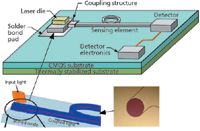
Figure 11: TDLAS sensor-on-a-chip concept in early development.
Summary Thoughts
From the perspective of sensing requirements for both methane and carbon dioxide as representative greenhouse gases, we have provided an overview of TDLAS sensing technologies that are currently used in the near infrared for aerial surveillance, open path, and point source monitoring. These sensors are starting to provide important data that can be used to better understand sources of anthropogenic and biogenic greenhouse gases. This information is useful in guiding the development of low-cost point sensors that can be combined into a network topology. The requisite underlying source technology in the MWIR region is under development in many organizations.
Acknowledgments
The authors gratefully acknowledge the contributions and participation of the US Department of Energy, Physical Sciences Inc., Heath Consultants Inc., Pacific Gas and Electric Co., Illinois State Geological Survey, and the California Energy Commission.
References
(1) D.T. Allen et.al, "Measurements of methane emissions at natural gas production sites in the United States," www.pnas.org/cgi/doi/10.1073/pnas.1304880110 (2013).
(2) A. Karion et al., Geophys. Res. Lett. 40, doi:10.1002/grl.50811 (2013).
(3) "America Pays for Gas Leaks," Report Prepared for Senator E.J. Markey, July 2013. Available at: http://www.markey.senate.gov/documents/markey_lost_gas_report.pdf.
(4) A.R. Brandt et al., Science 343, 733 (2014).
(5) Intergovernmental Panel on Climate Change (IPCC) (2007), IPCC Fourth Assessment Report: Climate Change 2007 (Cambridge University Press, Cambridge, UK).
(6) J.J. Dooley, R.T. Dahowski, and C.L. Davidson, "Comparing Existing Pipeline Networks with the Potential Scale of Future U.S. CO2 Pipeline Networks," PNNL-17381 Pacific Northwest National Laboratory (2008).
(7) D.E. Cooper and R.U. Martinelli, Laser Focus World, (November 1992).
(8) D.S. Bomse, Photonics Spectra 29(6) (1995).
(9) M.B. Frish and F. Klein, "Trace Gas Monitors based on Tunable Diode Laser Technology: An Introduction and Description of Applications," presented at the 5th International Symposium on Gas Analysis by Tunable Diode Lasers, Freiburg, Germany, 1998.
(10) M. Druy, M.B. Frish, and W.J. Kessler, Spectroscopy 21(3), 14–18 (2006).
(11) M.B. Frish, R.T. Wainner, J. Stafford-Evans, B.D. Green, M.G. Allen, S. Chancey, J. Rutherford, G. Midgley, and P. Wehnert, "Standoff Sensing of Natural Gas Leaks: Evolution of the Remote Methane Leak Detector (RMLD)," presented at the Conference on Lasers and Electro-optics/Quantum Electronics and Laser Science and Photonic Applications, Systems and Technologies 2005, Optical Society of America, Washington, D.C., 2005.
(12) M.B. Frish, and A.O. Wright, "Integrated Sensor for Remote Measurement of Heartbeat, Respiration, and Galvanic Skin Response," Final Report prepared for U.S. Air Force Research Laboratory under Contract No. FA8650-06-M-6703, PSI-2952/TR-2180, (January 2007).
(13) D.M. Sonnenfroh, E.W. Wetjen, M.G. Allen, C. Gmachl, F. Capasso, A.L. Hutchinson, D.L.Sivco, J.N. Baillargeon, and A.Y. Cho, "Mid-IR Gas Sensors Based on Quasi-CW Room-Temperature Quantum Cascade Lasers," paper number 2000-0641, AIAA 38th Aerospace Sciences Meeting, January, 2000.
(14) D.M. Sonnenfroh, M.B. Frish, R.T. Wainner, and M.G. Allen, "Mid-IR Quantum Cascade Laser Sensor for Tropospherically Important Trace Gases," Final Report prepared for U.S. Environmental Protection Agency under Order No. 4C-R348-NASA, PSI-2857/TR-1971, November, 2004, 12-13.
(15) D. Picciaia, G. Zazzeri, M.S. Gimberini, and P. Andreussi, "A New Remote Sensing Method for Landfill Emissions Quantification", Proceedings Sardinia 2011, Thirteenth International Waste Management and Landfill Symposium, S. Margherita di Pula, Cagliari, Italy; 3-7 (October 2011).
(16) M.B. Frish, "Overview of Sensitive Detection and Multiplexing Techniques for Tunable Diode Laser Absorption Spectroscopy," in OSA Trends in Optics and Photonics Vol. 31, Advanced Semiconductor Lasers and Their Applications, Leo Hollberg and Robert J. Lang, Eds. (Optical Society of America, Washington, DC, 2000).
(17) M.B. Frish and B.A. Cummings, "Laser Sensors for Gas Pipeline Explosion Protection," Final Report prepared for the California Energy Commission under Grant No 57238A/11-01G, PSI-1802/TR-2926, November 2013.
(18) M.B. Frish, M.C. Laderer, J.S.G. Stafford-Evans, J. Lewicki, and R. Locke, "Networked TDLAS Sensors for Sequestration MVA," presented at DoE Carbon Storage Program Infrastructure Annual Review Meeting, Pittsburgh, Pennsylvania, 2011.
(19) M.B. Frish and D.M. Sonnenfroh, "TDLAS Analyzers for Energy Production, Transmission, and Storage," presented at Field Applications in Industry and Research (FLAIR) 2011 Industry Session, Murnau, Germany, 2011.
(20) J. Zimmerman, C.Blakley, R. Locke, and M. Frish, "Final Report of TDLAS CO2 Sensor Field Testing at the Illinois Basin – Decatur Project," Illinois State Geological Survey, Champaign, Illinois (February 20, 2014).
(21) M.B. Frish, R. Shankar, I. Bulu, I. Frank, M.C. Laderer, R.T. Wainner, M.G. Allen, and M. Loncar, "Progress Toward Mid-IR Chip-Scale Integrated-Optic TDLAS Gas Sensors," presented at SPIE Photonics West, San Francisco, California, 2013.
(22) W.W. Bewley, C.D. Merritt, C.S. Kim, M. Kim, C.L. Canedy, I. Vurgaftman, J. Abell, and J.R. Meyer, Proc. of SPIE 8374, 83740H (2012).
Michael B. Frish is the area manager for industrial sensors at Physical Sciences Inc., in Andover, Massachusetts.

Michael B. Frish
Mark A. Druy is the technology transition manager at Physical Sciences Inc.

Mark A. Druy
Direct correspondence to: druy@psicorp.com
